Five Majestic Spinels Jewels – From Mongol To Modern

Exploring Badakhshan the ancient part of the Timurid Empire, Marco Polo mentioned “fine and valuable Balas Rubies” he could not stop admiring. Most probably named after the Barlas tribe who were remnants of the original Mongol army of Genghis Khan.
These colossal rubies were actually spinels, stones that had already been capturing the hearts, imaginations – and treasuries – of kings and queens for thousands of years.
Emperors of the ancient Persian Timurid dynasty prized large, high-quality polished spinels for their beauty and their value; they also considered these stones to be protective objects. According to renowned auction house Christie’s, Akbar the Great (1542-1605), the third Mughal emperor, collected spinels and wore them most often directly on the skin as a “life-protector” due to their blood-red color. A legend says that rulers were to wear at least three spinels during battles to protect them from injuries and death. Fortunately for modern historians, emperors would engrave their titles and names on the spinels as a mark of appreciation for the stone’s beauty. If the stone was passed to an heir, the son’s name and title were also engraved.
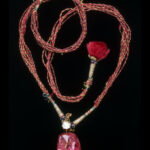
Carew Spinel.
Hung on a simple silk cord with a diamond on either side, the 133.5 carat Carew Spinel dates from those legendary times. The hefty stone, which is 4 cm tall and 2.3 cm wide, is engraved with the titles of three Moghul emperors (Jahangir (r.1605-27), Shah Jahan (dated 1629-30) and ‘Alamgir (Aurangzeb) (dated 1666). It is now in the V&A Museum in London.
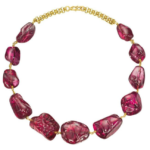
Mogul Names Necklace
With a total weight of an almost unbelievable 1,131.59 carats, the fabulous sold for $5.2 million at a Christie’s auction in 2011. The necklace has eleven polished red spinels; three are engraved with the names of Moghul emperors. The historical value – as well its large stones – makes this one of the most important spinel pieces in the world.
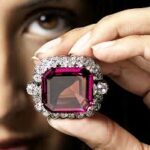
Hope Spinel.
Most of the world knows about the Hope Diamond; but did you know that there is a Hope Spinel? This plum-sized purple giant weighs in at 50.13 carats and is surrounded by diamonds. The octagonal step-cut spinel came into the collection of Henry Philip Hope in the 1800s, along with the Hope Diamond and other precious jewels. Designated an “exceptional treasure” by the Swiss Gemological Institute, the stone was auctioned for $1.4 million following a global bidding war.
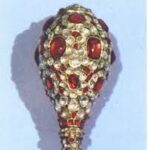
And the Royal Mace of Iran, from the 16th century Safavid dynasty is just one of the many magnificent pieces in the lavish and extremely valuable Iranian Crown Jewel collection. The Mace is 2.4 feet long and encrusted with diamonds and spinels. The six lustrous spinels at the top of the Mace are 40 carats apiece.
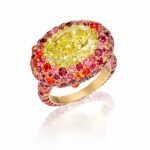
James de Givenchy & Inferno Spinel.
In more recent times, contemporary designers like David Yurman and James de Givenchy have created spinel jewelry that ranges from understated to extravagant. In particular, De Givenchy – the nephew of fashion designer Hubert de Givenchy – is renowned for his use of spinels, especially in his collection for Sotheby’s Diamonds: “cut to look ‘like red mirrors’ — to attract a new, more daring customer”; he says the spinels are “so much brighter than pavé rubies”. Meanwhile, de Givenchy’s spinel rings and bracelets incorporating spinels and mandarin garnets are already collectors’ pieces, while creations such as the Inferno Spinel and Sapphire Ricci Ring and the Diamond and Spinel Chrysanthemum Bracelet will make any gem lover’s mouth water.
http://www.christies.com/lotfinder/jewelry/an-imperial-mughal-spinel-necklace-5436541-details.aspx
A Historic Arcane Red Gem Makes Auction History
James de Givenchy at Simon Teakle
http://www.gemselect.com/gem-info/spinel/spinel-info.php#famous
http://www.en.safo.be/index.php/2010-11-23-17-19-10/2011-01-21-07-59-07
https://wanelo.com/p/39848682/group-of-six-diamond-and-spinel-star-brooches-circa-1890-lot-sotheby-s
http://collections.vam.ac.uk/item/O16068/the-carew-spinel-spinel-unknown/
https://www.academia.edu/4803084/A_HIGHLY_IMPORTANT_SPINEL_BEAD_DIAMOND_AND_PEARL_NECKLACE
https://www.bonhams.com/auctions/22642/lot/146/
http://robbreport.com/jewelry/hope-spinel-sells-world-record-14-million-bonhams-auction-video
